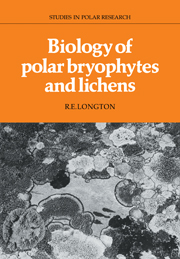Book contents
- Frontmatter
- Contents
- Preface
- 1 The polar regions
- 2 The cryptogamic vegetation
- 3 Pattern, process and environment
- 4 Radiation and microclimate
- 5 Physiological processes and response to stress
- 6 Vegetative growth
- 7 Cryptogams in polar ecosystems
- 8 Reproductive biology and evolution
- References
- Index of generic and specific names
- Subject index
2 - The cryptogamic vegetation
Published online by Cambridge University Press: 24 April 2010
- Frontmatter
- Contents
- Preface
- 1 The polar regions
- 2 The cryptogamic vegetation
- 3 Pattern, process and environment
- 4 Radiation and microclimate
- 5 Physiological processes and response to stress
- 6 Vegetative growth
- 7 Cryptogams in polar ecosystems
- 8 Reproductive biology and evolution
- References
- Index of generic and specific names
- Subject index
Summary
Vegetation classification
Boundaries between communities based on the distribution and abundance of cryptogams and of flowering plants may only partially coincide, as Alpert & Oechel (1982) demonstrated in Alaska. The most useful vegetation accounts thus consider all the major plant groups. The procedures of the Braun-Blanquet school have been adopted to define vegetation types at isolated Antarctic localities (Kappen, 1985a), and more comprehensively on Svalbard (Philippi, 1973), in the Soviet cold-Arctic (Aleksandrova, in press), in Greenland (Daniëls, 1982, 1985), and on Marion and Prince Edward Is (Gremmen, 1982). In a rather different approach, some Arctic lichen communities have been delimited by principal component analysis (Kershaw & Rouse, 1973; Richardson & Finegan, 1977), or by an agglomerative technique that indicates diagnostic species (Sheard & Geale, 1983). Although appearing with increasing frequency (e.g. Bliss & Svoboda, 1984), such quantitative analyses cannot yet form the basis for a comprehensive, objective classification of polar vegetation because of the limited database and differences in methodology. Thus Brossard, Deruelle, Nimis & Petit (1984) used small sample plots (100cm2) to study lichen-dominated vegetation on Svalbard, and as a consequence recognised communities on a smaller scale than those indicated by the conventional, larger quadrats.
In view of these problems, the present description of Antarctic vegetation is based on a hierarchical classification, formulated subjectively, with the major units defined by growth form. The two formations (Table 2.1) include vegetation dominated respectively by vascular and nonvascular plants, while subformations are based on growth form of the community dominants.
- Type
- Chapter
- Information
- Biology of Polar Bryophytes and Lichens , pp. 32 - 65Publisher: Cambridge University PressPrint publication year: 1988
- 2
- Cited by



